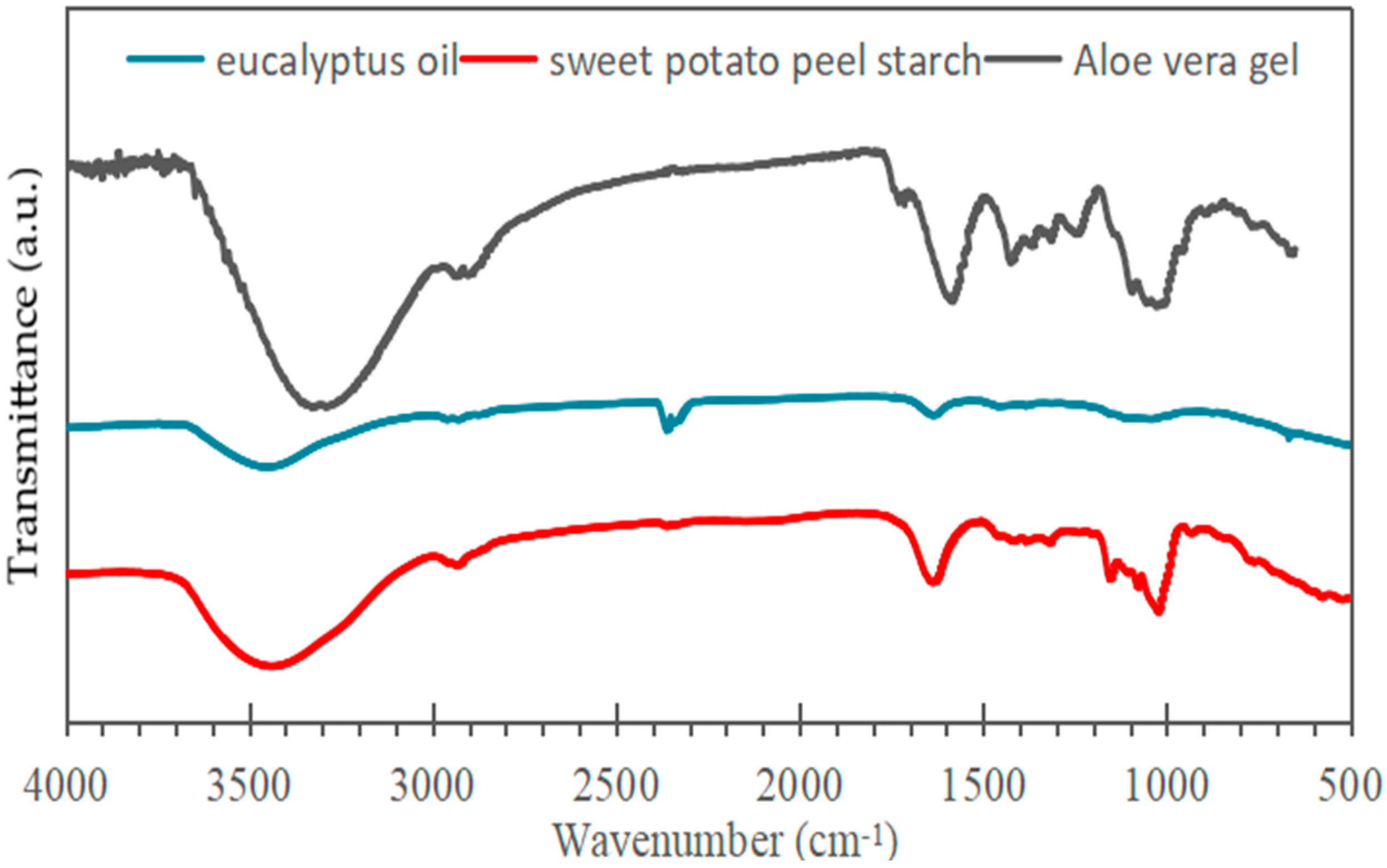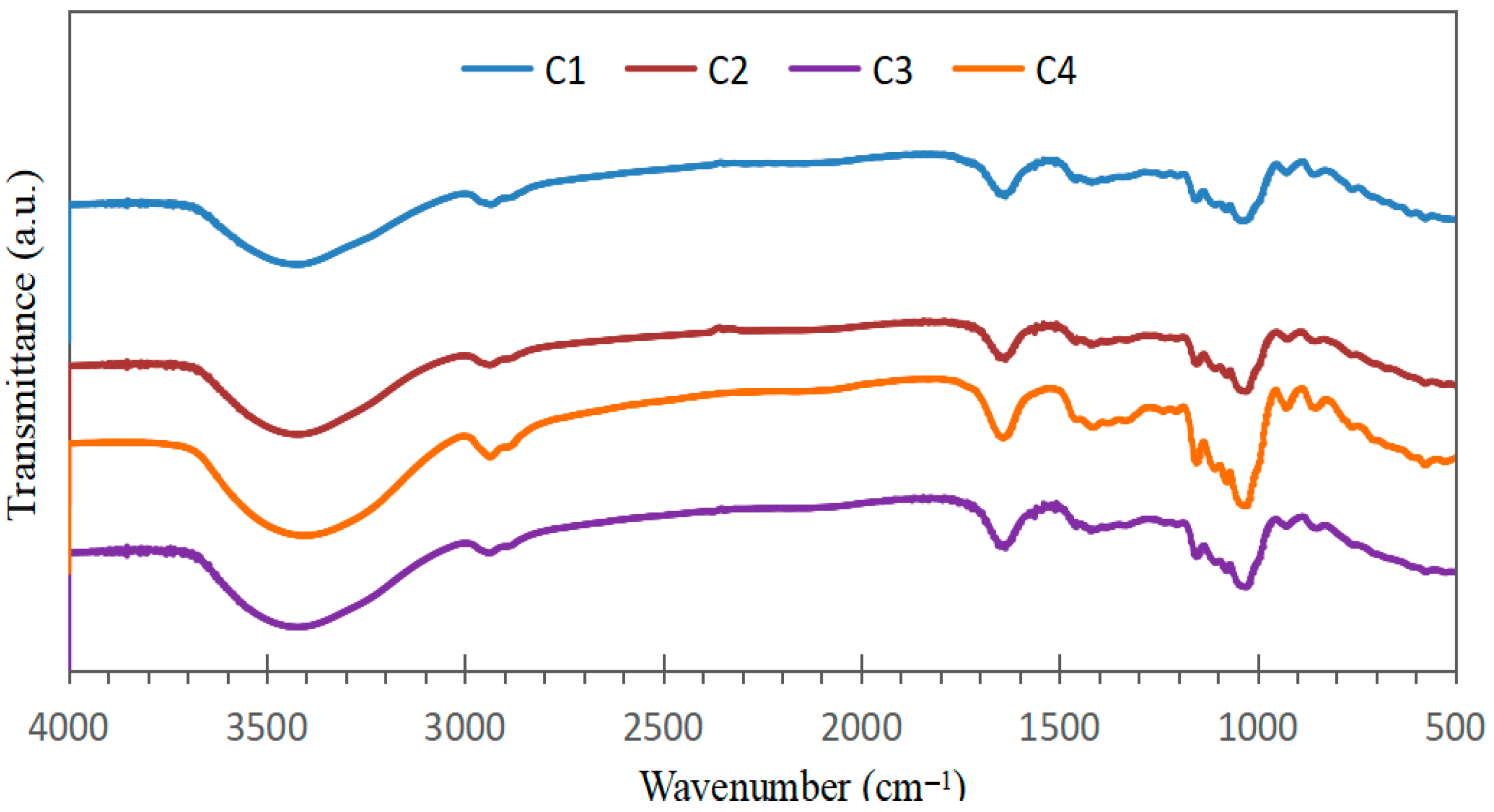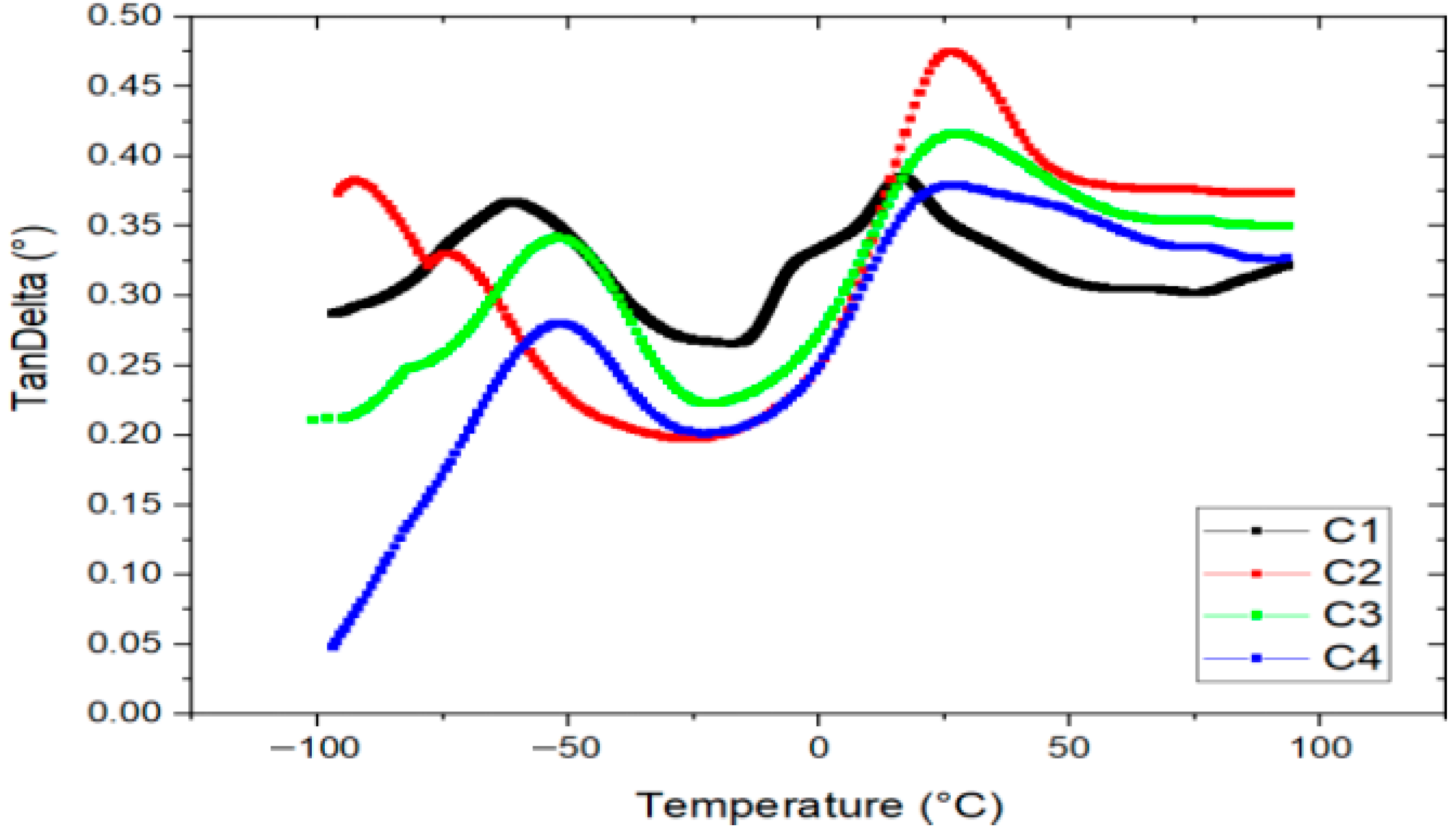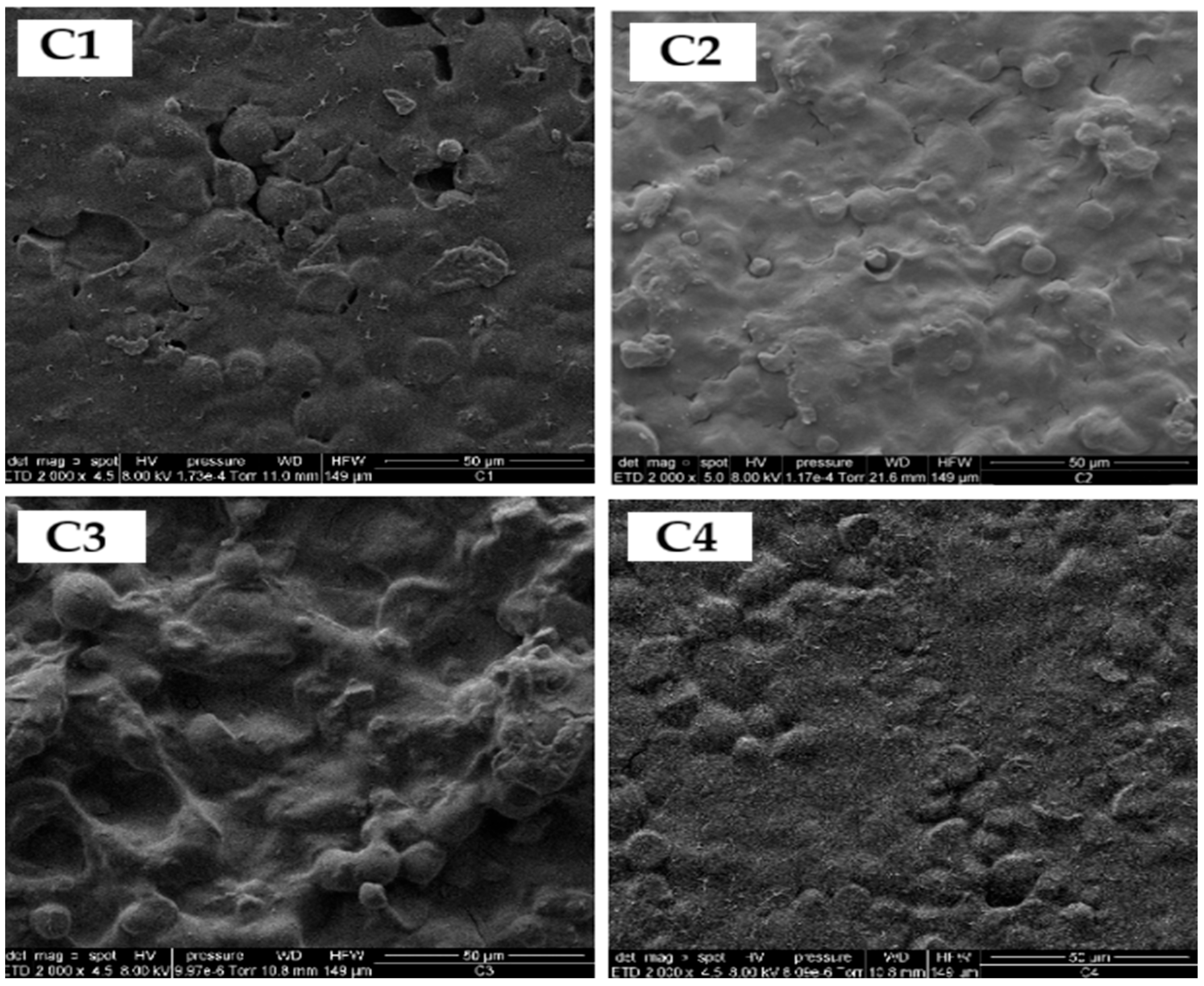Preparation and Characterization of Bioplastics Based on Sweet Potato Peel Starch, Aloe vera and Eucalyptus Oil
Abstract
1. Introduction
2. Materials and Methods
2.1. Materials
2.2. Methods
2.2.1. Extraction of Starch from Yellow Sweet Potato Peels
2.2.2. Extraction of Aloe vera Gel
2.2.3. Extraction of Eucalyptus Oil
2.2.4. Preparation of Bioplastic Films
2.2.5. Experimental Design
2.2.6. Characterization of the Components and Bioplastic Films
2.2.7. Statistical Analysis
3. Results and Discussion
3.1. Physicochemical Characterization of Sweet Potato Peel Starch
3.2. Chemical Structural Characterization of Film Components and Bioplastic
3.3. Evaluation of the Mechanical Properties of Bioplastic Films
3.4. Evaluation of Thermal Properties
3.4.1. Thermogravimetric Analysis of Bioplastic Films
3.4.2. Analysis by DSC of Bioplastic Films
3.4.3. Dynamic Mechanical Analysis
3.5. Morphological Evaluation of Bioplastic Films
3.6. Biodegradability Assessment
3.7. Evaluation of CO2 Emissions from Bioplastic Degradation
4. Conclusions
Author Contributions
Funding
Institutional Review Board Statement
Data Availability Statement
Acknowledgments
Conflicts of Interest
References
- Basurto, F.; Martinez, D.; Rodriguez, T.; Evangelista, V.; Mendoza, M.; Castro, D.; Gonzáles, J.; Vailón, V. Conocimiento actual del cultivo de camote (Ipomoea batatas Lam.) en México. Agroprod 2018, 30–34. Available online: https://www.revista-agroproductividad.org/index.php/agroproductividad/article/view/635/505 (accessed on 7 October 2025).
- Cantoral, E.; Chavez, A.; Flores, A. Nueva variedad de camote (Ipomoea batatas Lam.) con mejores características agronómicas y comerciales. Sci. Agropecu. 2020, 11, 39–48. [Google Scholar] [CrossRef]
- Widodo, Y.; Wahyuningsih, S.; Ueda, A. Sweet potato production for bioethanol and food related industry in Indonesia: Challenges for sustainability. Procedia Chem. 2015, 14, 493–500. [Google Scholar] [CrossRef]
- Fonseca, C.; Zuger, R.; Walker, T.; Molina, J. Estudio de Impacto de la Adopción de Las Nuevas Variedades de Camote Liberadas Por el INIA, en la Costa Central, Perú Caso del Valle de Cañete. Centro Internacional de la Papa: Lima, Peru. 2002. Available online: https://cipotato.org/wp-content/uploads/2014/09/SW63967.pdf (accessed on 7 October 2025).
- Julca, K.; Mendoza, M.; Villagómez, V. Optimal agronomic factors for commercial sweet potato production (Ipomoea batatas L., cv. Jonathan) on the Peruvian Central Coast. An. Científ. 2021, 82, 141–151. [Google Scholar] [CrossRef]
- Vidal, A.R.; Zaucedo, A.L.; Ramos, M.L. Nutrimental properties of the sweet potato (Ipomoea batatas L.) and its benefits in human health. Rev. Iberoam. Tecnol. Postcosecha. 2018, 19, 30–34. Available online: https://www.redalyc.org/articulo.oa?id=81357541001 (accessed on 7 October 2025).
- Zhao, S.; Zhong, L.; Li, X.; Qin, L.; Zhou, Y.; Lei, X.; Zheng, X.; Jin, K.; Pu, Z.; Hou, X.; et al. Comparative Analysis of Nutrients, Phytochemicals, and Minerals in Colored Sweet Potato (Ipomoea batatas L.) Roots. Foods 2024, 13, 3636. [Google Scholar] [CrossRef] [PubMed]
- Döhler, N.; Wellenreuther, C.; Wolf, A. Market dynamics of biodegradable bio-based plastics: Projections and linkages to European policies. EFB Bioeconomy J. 2022, 2, 100028. Available online: https://www.sciencedirect.com/science/article/pii/S2667041022000064 (accessed on 7 October 2025). [CrossRef]
- Rosenboom, J.G.; Langer, R.; Traverso, G. Bioplastics for a circular economy. Nat. Rev. Mater. 2022, 7, 117–137. [Google Scholar] [CrossRef]
- Narancic, T.; Cerrone, F.; Beagan, N.; O’Connor, K.E. Recent Advances in Bioplastics: Application and Biodegradation. Polymers 2020, 12, 920. [Google Scholar] [CrossRef] [PubMed]
- Sharma, S.; Kumar, G.; Bhardwaj, S.K.; Chauhan, A.; Rathi, A.; Kumar, J.; Sahil, K.; Vishvamitera, S. Bioplastics as next-generation eco-friendly materials: A comprehensive review. Clean Technol. Environ. Policy 2025, 27, 5009–5027. [Google Scholar] [CrossRef]
- Song, J.H.; Murphy, R.J.; Narayan, R.; Davies, H.L. Biodegradable and compostable alternatives to conventional plastics. Philos. Trans. R. Soc. B Biol. Sci. 2009, 364, 2127–2139. [Google Scholar] [CrossRef]
- Navia, D.P.; Villada, H.S. Impact of research on biodegradable packaging science, technology and innovation. Biotecnol. Sect. Agropecu. Agroind. 2013, 11, 173–180. Available online: http://www.scielo.org.co/scielo.php?script=sci_arttext&pid=S1692-35612013000200020 (accessed on 7 October 2025).
- Karimah, M.R.; Ridho, S.S.; Munawar, D.S.; Adi, R.; Ismadi, B.; Damayanti, W.; Subiyanto, A.; Fatriasari, F. A review on natural fibers for development of eco-friendly bio-composite: Characteristics, and utilizations. J. Mater. Res. Technol. 2021, 13, 2442–2458. [Google Scholar] [CrossRef]
- Huilcarema-Enríquez, K.; Amaguay, R.F.; Sevilla, J.D. Bioplásticos a partir de residuos agrícolas: Una revisión sistemática, tendencias y oportunidades actuales. Cienc. Lat. Rev. Científica Multidiscip. 2023, 8, 8997–9012. [Google Scholar] [CrossRef]
- Domínguez, R.N.; Arzate, I.; Chanona, J.J.; Welti, J.S.; Alvarado, J.S.; Calderón, G.; Garibay, V.; Gutiérrez, G.F. Aloe vera gel: Structure, chemical composition, processing, biological activity and importance in pharmaceutical and food industry. Rev. Mex. Ing. Quím. 2012, 11, 23–43. Available online: https://www.scielo.org.mx/scielo.php?script=sci_arttext&pid=S1665-27382012000100003 (accessed on 7 October 2025).
- Bakkali, F.; Averbeck, S.; Averbeck, D.; Idaomar, M. Biological effects of essential oils—A review. Food Chem. Toxicol. 2008, 46, 446–475. [Google Scholar] [CrossRef]
- Esen, G.; Azaz, A.D.; Kurkcuoglu, M.; Can Baser, K.H.; Tinmaz, A. Essential oil and antimicrobial activity of wild and cultivated Origanum vulgare L. subsp. hirtum (Link) Ietswaart from the Marmara region, Turkey. Flavour Fragr. J. 2007, 22, 371–376. [Google Scholar] [CrossRef]
- Zeng, W.; Zhang, Z.; Gao, H.; Jia, L.R.; He, Q. Chemical Composition, Antioxidant, and Antimicrobial Activities of Essential Oil from Pine Needle (Cedrus deodara). J. Food Sci. 2012, 77, 824–829. [Google Scholar] [CrossRef]
- Granados, C.; Santafé, G.G.; Acevedo, D. Chemical composition and evaluation of antioxidant activity of leaf essential oil Eucalyptus camaldulensis from Norte de Santander (Colombia). Rev. U.D.C.A Actual. Divulg. Cient. 2015, 18, 235–240. Available online: http://scielo.org.co/pdf/rudca/v18n1/v18n1a27.pdf (accessed on 7 October 2025).
- Huanca, C.; Castro, N.; López, J.; Bautista, N. Antibacterial activity and chemical composition of the essential oil of Aloysia aloysioides Loes. Rev. Soc. Quím. Perú 2021, 87, 195–206. [Google Scholar] [CrossRef]
- Puca, M.; Aguilar, M.; Canché, G.; Neira, M.G. Evaluation of thermal properties and permeability of bioplastic films based on starch, Aloe vera and graphene. Rev. Soc. Quím. Perú 2022, 88, 63–77. [Google Scholar] [CrossRef]
- Reynolds, T. Aloes: The Genus Aloe, 1st ed.; CRC Press: Boca Raton, FL, USA, 2024. [Google Scholar] [CrossRef]
- Puca, M.; Ascue, M.A.; Neira, M.G.; Girao, A.A.; Pilco, S.E.; Calla, M.K.; Arizaga, D.; Baro, F.L. Extraction of essential oil from eucalyptus leaves (eucalyptus globulus) by steam distillation and its physicochemical and microbiological characterization. Rev. Soc. Quím. Perú 2024, 90, 216–228. [Google Scholar] [CrossRef]
- Association of Official Analytical Chemists. Official Methods of Analysis of the Association of Official Analytical Chemists; AOAC International: Rockville, MD, USA, 2005. [Google Scholar]
- Hoover, R.; Ratnayake, W.S. Determination of total amylose content of starch. Curr. Protoc. Food Anal. Chem. 2001, E2.3.1–E2.3.5. [Google Scholar] [CrossRef]
- Grace, M. Elaboración de la Yuca; FAO: Roma, Italy, 1977; p. 116. ISBN 9253001719. [Google Scholar]
- Eshun, K.; He, Q. Aloe vera: A valuable ingredient for the food, pharmaceutical and cosmetic industries. Crit. Rev. Food Sci. Nutr. 2004, 44, 91–96. [Google Scholar] [CrossRef]
- Harmman, J.H. Composition and applications of Aloe vera leaf gel. Molecules 2008, 13, 1599–1616. [Google Scholar] [CrossRef]
- Rodríguez, V.M.; Femenia, A.; González, R.F.; Rocha, N.E.; Gallegos, J.A.; Candelas, M.G.; Ramírez, P.; Simal, S.; Rosselló, C. Effects of pasteurization on bioactive polysaccharide acemannan and cell wall polymers from Aloe barbadensis Miller. Carbohydr. Polym. 2011, 86, 1675–1683. [Google Scholar] [CrossRef]
- Femenia, A.; Sánchez, E.; Simal, S.; Rosselló, C. Compositional features of polysaccharides from Aloe vera (Aloe barbadensis Miller) plant tissues. Carbohydr. Res. 1999, 39, 109–117. [Google Scholar] [CrossRef]
- Ni, Y.; Turner, D.; Yates, K.M.; Tizard, I. Isolation and characterization of structural components of Aloe vera L. leaf pulp. Int. Immunopharmacol. 2004, 4, 1745–1755. [Google Scholar] [CrossRef] [PubMed]
- Dagne, E.; Bisrat, D.; Viljoen, A.; Van Wyk, B.E. Chemistry of Aloe species. Curr. Org. Chem. 2000, 4, 1055–1078. [Google Scholar] [CrossRef]
- Choi, S.; Chung, M.H. A review on the relationship between Aloe vera components and their biologic effects. Semin. Integr. Med. 2003, 1, 53–62. [Google Scholar] [CrossRef]
- Abdullah, A.H.D.; Pudjiraharti, S.; Karina, M.; Putri, O.D.; Fauziyya, R.H. Fabrication and characterization of sweet potato starch-based bioplastics plasticized with glycerol. J. Biol. Sci. 2019, 19, 57–64. [Google Scholar] [CrossRef]
- Nejatzadeh, F.; Enferadi, S.T. FT-IR study of the polysaccharides isolated from the skin juice, gel juice, and flower of Aloe vera tissues affected by fertilizer treatment. Org. Med. Chem. Lett. 2012, 2, 33. [Google Scholar] [CrossRef]
- Gentilini, R.; Bozzini, S.; Munarin, F.; Petrini, P.; Visai, L.; Tanzi, M.C. Pectins from Aloe vera: Extraction and production of gels for regenerative medicine. J. Appl. Polym. Sci. 2014, 131, 39760. [Google Scholar] [CrossRef]
- Jithendra, P.; Rajam, A.M.; Kalaivani, T.; Mandal, A.B.; Rose, C. Preparation and characterization of Aloe vera blended collagen-chitosan composite scaffold for tissue engineering applications. ACS Appl. Mater. Interfaces 2013, 5, 7291–7298. [Google Scholar] [CrossRef] [PubMed]
- Pinzón, M.I.; García, O.R.; Villa, C.C. The influence of Aloe vera gel incorporation on the physicochemical and mechanical properties of banana starch-chitosan edible films. J. Sci. Food Agric. 2018, 98, 4042–4049. [Google Scholar] [CrossRef] [PubMed]
- Awad, S.A. Mechanical and thermal characterisations of low-density polyethylene/nanoclay composites. Polym. Polym. Compos. 2020, 29, 1325–1332. [Google Scholar] [CrossRef]
- Abotbina, W.; Sapuan, S.M.; Sultan, M.T.H.; Alkbir, M.F.M.; Ilyas, R.A. Development and Characterization of Cornstarch-Based Bioplastics Packaging Film Using a Combination of Different Plasticizers. Polymers 2021, 13, 3487. [Google Scholar] [CrossRef]
- Smith, J.S.; Grant, D.B.; Smith, D.A. Molecular dynamics simulation study of nanoparticle interactions in a model polymer-nanoparticle composite. Compos. Sci. Technol. 2003, 63, 1599–1605. [Google Scholar] [CrossRef]
- Wang, S.; Nie, S.; Zhu, F. Chemical constituents and health effects of sweet potato. Food Res. Int. 2016, 89, 90–116. [Google Scholar] [CrossRef]
- Kaur, N.; Somasundram, C.; Razali, Z.; Mourad, A.I.; Hamed, F.; Ahmed, Z.F.R. Aloe vera/Chitosan-Based Edible Film with Enhanced Antioxidant, Antimicrobial, Thermal, and Barrier Properties for Sustainable Food Preservation. Polymers 2024, 16, 242. [Google Scholar] [CrossRef]
- Baruah, A.; Bordoloi, M.; Baruah, H.P.D. Aloe vera: A multipurpose industrial crop. Ind. Crops Prod. 2016, 94, 951–963. [Google Scholar] [CrossRef]
- Salaberria, A.M.; Diaz, R.H.; Labidi, J.; Fernandes, S.C.M. Role of chitin nanocrystals and nanofibers on physical, mechanical and functional properties in thermoplastic starch films. Food Hydrocoll. 2015, 46, 93–102. [Google Scholar] [CrossRef]
- Moncada, A.; Aranibar, N.; Pandia, S.; Aleman, M.; Renzo, R. Development and characterization of biofilms from mixtures of corn–potato starch, sorbitol and oregano essential oil (Origanum vulgare). Rev. Soc. Quím. Perú 2022, 88, 251–264. [Google Scholar] [CrossRef]
- Montero, M.; Morocho, M.; Avilés, D.; Carrasco, Á.; Erazo, R. Antimicrobial efficacy of eucalyptus essential oil (Eucalyptus spp.) on Escherichia coli and Staphylococcus aureus subsp. aureus strains. Rev. Investig. Vet. Perú 2019, 30, 932–938. [Google Scholar] [CrossRef]
- Chunkai, C.; Lin, L.; Zhang, G.; Xiujun, X.; Pang, B.; Junjie, J.; He, B.; Sun, F. Key unraveling crop enzymatic browning through integrated omics. Front. Plant Sci. 2024, 15, 1342639. [Google Scholar] [CrossRef]
- Rajamehala, M.; Reshma, M.; Kaniyamudhu, V.; Shruthika, K. Bioplastic production using Aloe vera gel as plasticizer: A sustainable approach. Curr. World Environ. 2024, 19, 1011–1021. [Google Scholar] [CrossRef]
- Puca, M.; Tinoco, O.R.; Canche, G.; Duarte, S.; Neira, M.G. Obtaining and characterization of bioplastics based on potato starch, aloe, and graphene. Polímeros 2022, 32, e2022037. [Google Scholar] [CrossRef]
- Mena, P.G.; Vaca, K.E.; Mena, J.A. Bioplásticos y su impacto ambiental: Producción a partir de fuentes renovables y comparación con plásticos convencionales. Cienc. Lat. Rev. Científica Multidiscip. 2025, 9, 10318–10334. [Google Scholar] [CrossRef]
- Adamcová, D.; Zloch, J.; Brtnický, M.; Vaverková, M.D. Biodegradation of polymers and compost quality. J. Polym. Environ. 2019, 27, 892–899. [Google Scholar] [CrossRef]












| Code | Experimental Run (Aloe) (Oil) | Aloe vera Gel Concentration * (% w/w) | Eucalyptus Oil Concentration (% w/w) | Gliceryn (% w/w) | Starch (% w/w) | Water (% w/w) |
|---|---|---|---|---|---|---|
| C1 | (+) (+) | 70 | 0.6 | 2 | 5 | 22.4 |
| C2 | (−) (−) | 20 | 0.2 | 2 | 5 | 72.8 |
| C3 | (+) (−) | 70 | 0.2 | 2 | 5 | 22.8 |
| C4 | (−) (+) | 20 | 0.6 | 2 | 5 | 86.4 |
| Characteristic | Yellow Sweet Potato Peel Starch | Method |
|---|---|---|
| Starch Yield (%) | 3.54 ± 0.11 | Gravimetric Method [22] |
| Humidity (%) | 9.84 ± 1.23 | AOAC 950.46 [25] |
| Total protein (%) | 0.53 ± 0.05 | AOAC 984.13 [25] |
| Fat (%) | 0.56 ± 0.01 | AOAC 2003.05 [25] |
| Crude fiber (%) | 0.02 ± 0.01 | AOAC 962.09 [25] |
| ELN * (%) | 87.88 ± 0.05 | AOAC 976.05 [25] |
| Ash (%) | 1.44 ± 0.01 | AOAC 942.05 [25] |
| Amylose (%) | 17.56 ± 8.45 | Hoover and Ratnayake [26] |
| Amylopectin (%) | 82.44 ± 8.75 | Hoover and Ratnayake [26] |
| Gelatinization temperature (%) | 68.90 ± 1.85 | Grace [27] |
| Code | Experimental Run (Aloe) (Oil) | Young’s Module (MPa) | Maximum Tensile Strength (MPa) | Elongation at Break (%) |
|---|---|---|---|---|
| C1 | (+) (+) | 41.1 ± 11.1 | 2.1 ± 0.4 | 21.6 ± 4.3 |
| C2 | (−) (−) | 20.6 ± 8.7 | 1.9 ± 0.2 | 15.4 ± 1.9 |
| C3 | (+) (−) | 34.4 ± 8.8 | 1.8 ± 0.4 | 15.6 ± 4.4 |
| C4 | (−) (+) | 29.2 ± 2.8 | 1.4 ± 0.1 | 12.7 ± 2.4 |
| Source | MC Ajust. | F Value | p Value |
|---|---|---|---|
| Young’s modulus (MPa): | |||
| A: Aloe vera concentration (% w/w) | 495.368 | 6.99 | 0.030 * |
| B: Eucalyptus oil concentration (% w/w) | 175.568 | 2.48 | 0.154 |
| AB | 2.708 | 0.04 | 0.850 |
| Maximum tensile strength (MPa): | |||
| A: Aloe vera concentration (% w/w) | 0.26108 | 2.94 | 0.125 |
| B: Eucalyptus oil concentration (% w/w) | 0.01687 | 0.19 | 0.675 |
| AB | 0.51668 | 5.81 | 0.043 * |
| Elongation at break (%): | |||
| A: Aloe vera concentration (% w/w) | 62.108 | 62.108 | 0.050 |
| B: Eucalyptus oil concentration (% w/w) | 8.168 | 8.168 | 0.428 |
| AB | 56.768 | 56.768 | 0.059 |
| Code | Design | First Decomposition Zone (60–260 °C) | Second Decomposition Zone (260–340 °C) | ||
|---|---|---|---|---|---|
| Loss Mass (%) | TDmax (°C) | Loss Mass (%) | TDmax (°C) | ||
| C1 | (+) (+) | 17.4 | 141.3 | 67.3 | 283.2 |
| C2 | (−) (−) | 18.8 | 177.9 | 59.5 | 292.4 |
| C3 | (+) (−) | 12.6 | 112.5 | 69.0 | 285.1 |
| C4 | (−) (+) | 30.9 | 164.4 | 54.3 | 294.1 |
| Code | Design | Mass of CO2 (kg)/kg of Bioplastic |
|---|---|---|
| C1 | (+) (+) | 0.2084 ± 0.0045 |
| C2 | (−) (−) | 0.3847 ± 0.0102 |
| C3 | (+) (−) | 0.2216 ± 0.0056 |
| C4 | (−) (+) | 0.2688 ± 0.0063 |
| Source | MC Ajust. | F Value | p Value |
|---|---|---|---|
| A: Aloe vera concentration (% w/w) | 0.037464 | 767.16 | 0.000 * |
| B: Eucalyptus oil concentration (% w/w) | 0.012500 | 255.97 | 0.000 * |
| AB | 0.007910 | 161.98 | 0.000 * |
Disclaimer/Publisher’s Note: The statements, opinions and data contained in all publications are solely those of the individual author(s) and contributor(s) and not of MDPI and/or the editor(s). MDPI and/or the editor(s) disclaim responsibility for any injury to people or property resulting from any ideas, methods, instructions or products referred to in the content. |
© 2025 by the authors. Licensee MDPI, Basel, Switzerland. This article is an open access article distributed under the terms and conditions of the Creative Commons Attribution (CC BY) license (https://creativecommons.org/licenses/by/4.0/).
Share and Cite
Puca-Pacheco, M.; Neira-Velázquez, M.G.; Canché-Escamilla, G.; Ascue-Caballero, M.; Girao-Sánchez, A.A.; Tacuri-Puca, C.A. Preparation and Characterization of Bioplastics Based on Sweet Potato Peel Starch, Aloe vera and Eucalyptus Oil. Polymers 2025, 17, 2950. https://doi.org/10.3390/polym17212950
Puca-Pacheco M, Neira-Velázquez MG, Canché-Escamilla G, Ascue-Caballero M, Girao-Sánchez AA, Tacuri-Puca CA. Preparation and Characterization of Bioplastics Based on Sweet Potato Peel Starch, Aloe vera and Eucalyptus Oil. Polymers. 2025; 17(21):2950. https://doi.org/10.3390/polym17212950
Chicago/Turabian StylePuca-Pacheco, Mercedes, María Guadalupe Neira-Velázquez, Gonzalo Canché-Escamilla, Melanie Ascue-Caballero, Alvaro Adrian Girao-Sánchez, and César Augusto Tacuri-Puca. 2025. "Preparation and Characterization of Bioplastics Based on Sweet Potato Peel Starch, Aloe vera and Eucalyptus Oil" Polymers 17, no. 21: 2950. https://doi.org/10.3390/polym17212950
APA StylePuca-Pacheco, M., Neira-Velázquez, M. G., Canché-Escamilla, G., Ascue-Caballero, M., Girao-Sánchez, A. A., & Tacuri-Puca, C. A. (2025). Preparation and Characterization of Bioplastics Based on Sweet Potato Peel Starch, Aloe vera and Eucalyptus Oil. Polymers, 17(21), 2950. https://doi.org/10.3390/polym17212950






